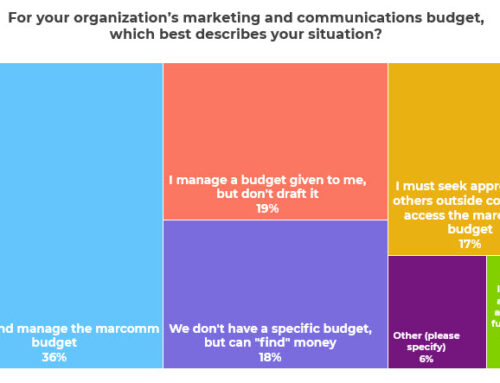I just finished up our two-part webinar series on how to measure the effectiveness of your communications work. (If you missed it, All-Access Pass Holders get access to the recordings).
Part of the challenge with answering the “what should we measure” and “what numbers should I pay attention to” questions for nonprofits is that it depends.
It depends first and foremost on your goals. But it also depends on other factors, such as how easy those measures are to get and how meaningful they really are.
To help you sort out your options and narrow down the hundreds of possible statistics to just a handful that are most important, I recommend that you ask yourself and your team these questions.
Question #1: What are our communications goals?
Nonprofit communications teams work on some subset of these 12 goals:
Community Engagement and Education Goals
- Engaging our community to keep people inspired by and active in our work
- Raising awareness of our issues to educate people on our cause
- Advocating on our issues to change hearts and minds
Brand and Leadership Goals
- Brand building and reputation management for the organization
- Positioning our staff as thought leaders or experts
- Communicating internally with our staff or board
Program Recruitment Goals
- Recruiting and engaging participants to use our programs or services
- Building our membership by recruiting and serving members of our organization
- Recruiting and engaging volunteers to help deliver our programs and services
Fundraising Goals
- Supporting fundraising from individuals making small to medium gifts
- Supporting major donor fundraising
- Supporting event fundraising (galas, walks, etc.)
What are your top three? Start with just three for your measurement conversation. If you can pick just one, even better. You’ll need to take the next questions goal by goal.
Question #2: For each goal, what does the desired result actually look like at our organization?
Get specific, because words like “awareness” and “engagement” can look like very different things to different people.
For example, “brand awareness” could mean “we want people to know they can turn to us for help with that problem” or “we want the media to call us every time they do a story on this issue.” Those are two very different versions of “awareness” that you would measure in different ways.
“Community engagement” could mean “we want to give people hope that there’s a solution to this challenge” or “we want to rally public support for these policy changes.”
You really have to get specific about what the desired results are in the context of your organization’s work.
Question #3: Given our communications strategies to reach that desired result, what metrics could indicate that we making progress toward that goal?
Let’s take “we want people to know they can turn to us for help.” Let’s say the communications strategies you use run from blogging to PR to paid advertising and more. That means your possible metrics could include:
- Your search engine optimization results on specific terms
- How much earned media you get
- How much traffic your paid ads generate
- How much traction your influencer campaigns produce
- And many others you could add to this list
You should have a list of potential metrics related to your goal/desired result/communications strategies now. But how do you select from all of those choices? That brings us to the next question, which is the hardest . . .
Question #4: What’s the most strategic or effective or highest priority?
OK, this is a tough one, because the question you ask here actually depends on which goal you are talking about. But the idea is to ask another question that helps you separate the most strategic metrics out from the long list of possible options.
For awareness questions, I would ask: What comes after awareness? If you are building awareness with hopes to fundraise from those people, your metrics should include some form of list building so you can directly ask for donations. If you are building awareness with the intent to educate people more deeply about your issue, you may be more interested in getting people to spend more time exploring your website or registering for workshops.
For engagement questions, I would ask: What do we want most people to do to demonstrate their full engagement? Answers might include “talking to others” or “showing up at events.” Those answers help you pinpoint which metrics matter most.
In some cases, you’ll need to ask which target audience is most important and select the metrics that are the best indicators that you are connecting with those specific kinds of people.
Figure out your strategic question and the answer will help you winnow down your list.
Question #5: Of the remaining possible metrics, which is both easiest to track and easiest to make progress on?
If it’s not easy to track the number, you won’t.
If you can’t make progress on the number — no matter what you do, it won’t budge — then it’s not worth tracking either.
Your final list of metrics should be relatively easy to track, easy to make progress on, easy to attribute that progress to your communications efforts, clearly connected to your organizational goals and desired results, and short! Especially for boards, I recommend no more than 3-5 key performance indicators.
So next time you ask, “Should I track this metric and report it to my board?” try to ask yourself these questions first to find the answer!






